Abstract
Seismic reflection profiles indicate the compressive nature of the structural style associated with the major uplift events in the Cooper–Eromanga Basins. Inversion geometries and reactivated features attest to a period of compression during Late Triassic–Early Jurassic times. In the Eromanga Basin, compressional structural styles associated with Late Cretaceous–Tertiary are apparent. Many of the Late Cretaceous–Tertiary structures coincide with exhumation highs in Late Cretaceous–Tertiary times. The two-layer lithospheric compression model is considered as the most complete explanation of both the uplift of areas subject to compression and crustal thickening, and of the regional uplift of areas not subject to any apparent Late Cretaceous–Tertiary compression. In the model, compression and thickening in the lower lithosphere is decoupled and laterally displaced from that in the upper crust. Thickening of the mantle lithosphere without thickening of the overlying crust can account for the initial subsidence then uplift of not inverted platform areas. The opening of the Tasman Sea and the Coral Seas can lead to stress transmission in the interior of the continent. These stresses are likely to generate uplift but cannot explain the distribution of uplift in areas not subject to compression.








Similar content being viewed by others
References
Betts PG, Giles D, Lister GS, Frick LR (2002) Evolution of the Australian lithosphere. Aust J Earth Sci 49:661–695
Bowering OJW (1982) Hydrodynamics and hydrocarbon migration. A model for the Eromanga Basin. Aust Petroleum Explor Assoc J 22:227–236
Brodie J, White N (1995) The link between sedimentary basin inversion and igneous underplating. In: Buchanan JG, Buchanan PG (eds) Basin inversion, vol 88. Geological Society of London Special Publication, UK, pp 21–38
Brown RW (1991) Backstacking apatite fission-track ‘stratigraphy’: a method for resolving the erosional and isostatic rebound components of tectonic uplift histories. Geology 19:74–77
Callen RA, Tedford HA (1986) New Cainozoic rock units and depositional environments, Lake Frome area, South Australia. R Soc South Aust Trans 100:125–167
Cande SC, Mutter JC (1982) A revised identification of the oldest sea-floor spreading anomalies between Australia and Antarctica. Earth Planet Sci Lett 58:151–160
Chadwick RA (1985) Permian, Mesozoic and Cenozoic structural evolution of England and Wales in relation to the principles of extension and inversion tectonics. In: Whittaker A (ed) Atlas of onshore sedimentary basins in England and Wales: post-carboniferous tectonics and stratigraphy. Blackie, Glasgow, pp 9–25
Cloetingh S, McQueen H, Lambeck K (1985) On a tectonic mechanism for regional Sea level variations. Earth Planet Sci Lett 75:157–166
Coventry RJ, Stephenson PJ, Webb AB (1985) Chronology of landscape and soil development in the upper Flinders Range area, Queensland, based on isotopic dating of Cainozoic basalts. Aust J Earth Sci 32:433–447
Coward MP (1986) Heterogemous stretching, simple shear and basin development. Earth Planet Sci Lett 80:325–336
Crook KW, Belbin L (1978) The southwest Pacific area during the last 90 million years. Geol Soc Aust J 25:23–40
England P, Molnar P (1990) Surface uplift, uplift of rocks, and exhumation of rocks. Geology 18:1173–1177
Etheridge M, McQueen H, Lambeck K (1991) The role of intraplate stress in Tertiary (and Mesozoic) deformation of the Australian continent and its margins: a key factor in the petroleum trap formation. Explor Geophys 22:123–128
Finlayson DM, Leven JH, Etheridge MA (1988) Structural styles and basin evolution in eromanga region, Eastern Australia. Am Assoc Petroleum Geol Bull 72:33–48
Gallagher K (1990) Permian-Cretaceous subsidence history along the Eromanga-Brisbane Geoscience Transect. In: Finlayson DM (ed) The Eromanga-Brisbane Geoscience transect: a guide to basin development across the Phanerozoic Australia in southern Queensland, vol 232. Bureau of Mineral Resources. Geology and Geophysics Bulletin, Australia, pp 133–151
Gallagher K, Dumitru TA, Gleadow JW (1994) Constraints on the vertical motion of eastern Australia during the Mesozoic. Basin Res 6:77–94
Garfunkel Z (1988) Relation between continental rifting and uplifting: evidence from the Suez rift and northern Red Sea. Tectonophysics 150:33–49
Gravestock DI, Callen RA, Alexander EM, Hill AJ (1995) Strzelecki South Australia. In: Fairburn WA (ed) Explanatory Notes-1:250,000 Geological Series. Geological Survey of South Australia and Department of Mines and Energy South Australia, pp 1–45
Gurnis M, Müller RD, Moresi L (1998) Cretaceous vertical motion of Australia and the Australia-Antarctic discordance. Science 279:1499–1504
Gurnis M, Moresi L, Mueller RD (2000) Models of mantle convection incorporating plate tectonics. The Australian region since the Cretaceous. In: Richards MA, Gordon R, Van Der Hilst R (eds) The history and dynamics of global plate motions. American Geophysical Union, Washington, DC, pp 211–238
Harland WB, Armstrong RL, Cox AV, Craig LE, Smith AG, Smith DG (1989) A geological time scale. Cambridge University Press, Cambridge, pp 1–263
Hellinger SJ, Sclater JG (1983) Some comments on two-layer extensional models for the evolution of sedimentary basins. J Geophys Res B88:8251–8269
Hillis RR (1992) A two-layer lithospheric compressional model for the Tertiary uplift of the southern United Kingdom. Geophys Res Lett 19:573–576
Jones JG, Veevers JJ (1982) A Cainozoic history of Australia’s Southeast Highlands. Geol Soc Aust J 29:1–12
Kuang KS (1985) History and style of Cooper-Eromanga Basin structures. Explor Geophys 16:245–248
Kusznir NJ, Karner GD, Egan S (1987) Geometric, thermal and isostatic consequences of detachments in continental lithosphere extension and basin formation. In: Beaumont C, Tankard AJ (eds) Sedimentary basins and basin-forming mechanisms, vol 12. Canadian Society of Petroleum Geologists Memoir, Canada, pp 185–203
Mavromatidis A (1997) Quantification of Exhumation in the Cooper-Eromanga basins and its implications for hydrocarbon exploration. Ph.D. thesis, The University of Adelaide, Australia, pp 1–330
Mavromatidis A, Hillis RR (2005) Quantification of exhumation in the Eromanga Basin and its implications for hydrocarbon exploration. Petroleum Geosci 11:79–92
Middleton MF, Hunt J (1989) Influence of tectonics on Permian coal-rank patterns in Australia. Int J Coal Geol 13:391–411
Mitrovica JX, Beaumont C, Jarvis JT (1989) Tilting of continental interiors by the dynamical effects of subduction. Tectonics 8:1079–1094
Moore PS (1986) An exploration overview of the Eromanga Basin. In: Gravestock DI, Moore PS, Pitt GM (eds) Contributions to the geology and hydrocarbon potential of the Eromanga Basin, vol 12. Geological Society of Australia Special Publication, Australia, pp 1–8
Moore PS, Pitt GM (1984) Cretaceous of the Eromanga Basin—implications for hydrocarbon exploration. Aust Petroleum Explor Assoc J 24:358–376
Murrell SAF (1986) Mechanics of tectogenesis in plate collision zones. In: Cowar MP, Ries AC (eds) Collision tectonics, vol 19. Geological Society of London Special Publication, UK, pp 95–111
Ollier CD (1982) The Great Escarpment of eastern Australia: tectonic and geomorphic significance. Geol Soc Aust J 29:13–24
Royden L, Keen CE (1980) Rifting processes and thermal evolution of the continental margin of eastern Canada determined from subsidence curves. Earth Planet Sci Lett 51:343–361
Russell M, Gurnis M (1994) The planform of epeirogeny: vertical motions of Australia during the cretaceous. Basin Res 6:63–76
Sandiford M, Powell R (1990) Some isostatic and thermal consequences of the vertical strain geometry in convergent orogens. Earth Planet Sci Lett 98:154–165
Senior BR, Mond A, Harrison PL (1978) Geology of the Eromanga Basin. Bur Miner Resour Bull 167:102–108
Shaw RD (1990) Development of the Tasman Sea and easternmost Australian continental margin—a review. In: Finlayson DM (ed) The Eromanga-Brisbane Geoscience transect: a guide to basin development across the Phanerozoic Australia in southern Queensland, vol 232. Bureau of Mineral Resources, Geology and Geophysics Bulletin, Australia, pp 53–66
Shaw RD (1991) Tertiary structuring in Southwest Queensland: implications for petroleum exploration. Explor Geophys 22:339–344
Sprigg RC (1958) Petroleum prospects of western parts of Great Australian Artesian Basin. Am Assoc Petroleum Geol Bull 42:2465–2491
Sprigg RC (1961) On the structural evolution of the Great Artesian Basin. Aust Petroleum Explor Assoc J 1:37–56
Stuart WJ (1976) The genesis of Permian and Lower Triassic reservoir sandstones during phases of southern Cooper Basin Development. Aust Petroleum Explor Assoc J 16:37–47
Thornton RCN (1979) Regional stratigraphic analysis of the Gidgealpa Group, southern Cooper Basin, Australia. South Aust Geol Surv Bull 49:1–140
Veevers JJ (1986) Breakup of Australia and Antarctica estimated as mid-Cretaceous (95 ± 5 Ma) from magnetic and seismic data at the continental margin. Earth Planet Sci Lett 77:91–99
Veevers JJ, Jones JG, Powell CM (1982) Tectonic framework of Australia’s sedimentary basins. Aust Petroleum Explor Assoc J 22:283–297
Wecker HRB (1989) The Eromanga Basin. Aust Petroleum Explor Assoc J 29:379–397
Wellman P (1987) Eastern Highlands of Australia; their uplift and erosion. Bur Miner Resour J Aust Geol Geophys 10:277–286
White R, McKenzie D (1988) Formation of the “steer’s head” geometry of sedimentary basins by differential stretching of the crust and mantle. Geology 16:250–253
White R, McKenzie D (1989) Magmatism at rift zones: the generation of volcanic continental margins and flood basalts. J Geophys Res B94:76885–7729
Williams T, Moriarty K (1986) Hydrocarbon flushing in the Eromanga Basin fact or fallacy? In: Gravestock DI, Moore PS, Pitt GM (eds) Contributions to the geology and hydrocarbon potential of the Eromanga Basin, vol 12. Geological Society of Australia Special publication, Australia, pp 377–384
Wopfner H (1960) On some structural developments in the central part of the Great Artesian Australian Basin. Trans R Soc South Aust 83:179–193
Wopfner H, Callen RA, Harris WK (1974) The lower Tertiary Eyre Formation of the southwestern Great Artesian Basin. Geol Soc Aust J 21:17–52
Acknowledgements
The present work has been made possible thanks to Santos Ltd., for providing the data and the well completion reports. Comments from two anonymous reviewers and Prof. R. O. Greiling are sincerely appreciated and greatly improved the manuscript.
Author information
Authors and Affiliations
Corresponding author
Rights and permissions
About this article
Cite this article
Mavromatidis, A. Two layer model of lithospheric compression and uplift/exhumation in an intracratonic setting: an example from the Cooper–Eromanga Basins, Australia. Int J Earth Sci (Geol Rundsch) 97, 623–634 (2008). https://doi.org/10.1007/s00531-007-0260-5
Received:
Accepted:
Published:
Issue Date:
DOI: https://doi.org/10.1007/s00531-007-0260-5




